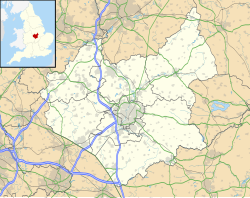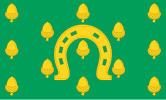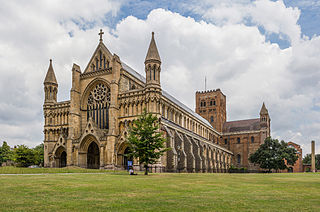
St Albans Cathedral, officially the Cathedral and Abbey Church of St Alban but often referred to locally as "the Abbey", is a Church of England cathedral in St Albans, England.
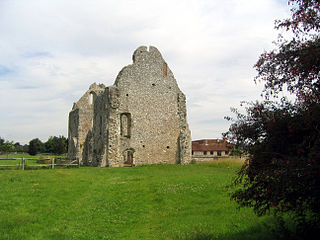
Boxgrove Priory is a ruined priory in the village of Boxgrove in Sussex, England. It was founded in the 12th century.
Roger Bigod was a Norman knight who travelled to England in the Norman Conquest. He held great power in East Anglia, and five of his descendants were earls of Norfolk. He was also known as Roger Bigot, appearing as such as a witness to the Charter of Liberties of Henry I of England.

Newstead Abbey, in Nottinghamshire, England, was formerly an Augustinian priory. Converted to a domestic home following the Dissolution of the Monasteries, it is now best known as the ancestral home of Lord Byron.

Belvoir Castle is a faux historic castle and stately home in Leicestershire, England, situated 6 mi (10 km) west of the town of Grantham and 10 mi (16 km) northeast of Melton Mowbray. A castle was first built on the site immediately after the Norman Conquest of 1066 and has since been rebuilt at least three times. The final building is a grade I listed mock castle, dating from the early 19th century. It is the seat of David Manners, 11th Duke of Rutland, whose direct male ancestor inherited it in 1508. The traditional burial place of the Manners family was in the parish church of St Mary the Virgin, Bottesford, situated 3 mi (5 km) to the north of the Castle, but since 1825 they have been buried in the ducal mausoleum built next to the Castle in that year, to which their ancient monuments were moved. It remains the private property of the Duke of Rutland but is open to the general public.
Luffield Abbey is a place in the very north of Buckinghamshire, England. It is on the border with Northamptonshire, close to Biddlesden and Silverstone.

Tynemouth Castle is located on a rocky headland, overlooking Tynemouth Pier. The moated castle-towers, gatehouse and keep are combined with the ruins of the Benedictine priory where early kings of Northumbria were buried. The coat of arms of the town of Tynemouth still includes three crowns commemorating the tradition that the Priory had been the burial place for three kings.

The Tironensian Order or the Order of Tiron was a medieval monastic order named after the location of the mother abbey in the woods of Thiron-Gardais in Perche, some 35 miles west of Chartres in France). They were popularly called "Grey Monks" because of their grey robes, which their spiritual cousins, the monks of Savigny, also wore.

Alien priories were religious establishments in England, such as monasteries and convents, which were under the control of another religious house outside England. Usually the mother-house was in France.
Sopwell Priory was a Benedictine nunnery founded around 1140 on the site of an ancient hermitage in Sopwell, Hertfordshire, England. After the Dissolution, the priory was torn down and a Tudor manor house constructed in its place.

Llanthony Priory is a partly ruined former Augustinian priory in the secluded Vale of Ewyas, a steep-sided once-glaciated valley within the Black Mountains area of the Brecon Beacons National Park in Monmouthshire, south east Wales. It lies seven miles north of Abergavenny on an old road to Hay-on-Wye at Llanthony. The priory ruins lie to the west of the prominent Hatterrall Ridge, a limb of the Black mountains. The main ruins are under the care of Cadw and entrance is free.
Wallingford Priory was a Benedictine priory dedicated to the Holy Trinity in Wallingford in the English county of Berkshire. Nothing remains of Holy Trinity Priory, which is believed to have stood on the site of the Bullcroft recreation ground off the High Street.
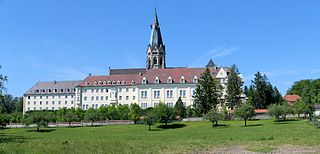
St. Ottilien Archabbey is a Benedictine monastery in Emming near Eresing and the Ammersee in the district of Landsberg, Oberbayern, Germany. It is the motherhouse of the St. Ottilien Congregation.
William of Wallingford was the 47th abbot of St Albans Abbey. He was a Benedictine monk at Holy Trinity Priory, Wallingford, Berkshire, England and like John of Wallingford and Richard of Wallingford, moved from this cell of St Albans Abbey to the abbey itself. He was a favourite of John Stoke, 44th abbot of St Albans, also from Wallingford. On his deathbed in 1451, Stoke was supposed to have given William and Thomas Wallingford, his senior chaplain, charge over 1000 marks but after his death they could only account for 250 marks. The abbot John Wheathampstead who succeeded Stoke suspected the two over the money. Nevertheless, William of Wallingford was later appointed abbot in 1476, after the death of William Albone, apparently for his financial acumen, at a time when the abbey was in debt. William of Wallingford managed to get rid of the debt whilst also spending on the abbey. He built the high altar known as the Wallingford Screen at a cost of £733 and completed the chapter house. The statues on it were destroyed during the Dissolution but were replaced in Victorian times.

The Priory of St. Mary the Virgin and St. Martin of the New Work, or Newark, commonly called Dover Priory, was a priory at Dover in southeast England. It was variously independent in rule, then occupied by canons regular of the Augustinian rule, then finally monks of the Benedictine rule as a cell of Christchurch Monastery, Canterbury.
Colne Priory at Earls Colne, Essex was a Benedictine priory, initially a dependent cell of Abingdon Abbey, Berkshire. It was founded by Aubrey de Vere I and his wife Beatrice in or before 1111. One piece of research suggests that the original Abbot, Faritius, was appointed in 1101; he initially placed six monks at the site. Their eldest son Geoffrey had died at Abingdon about seven or eight years earlier and was buried there. On his deathbed, Geoffrey had bequeathed to Abingdon the church and lands at Kensington, Middlesex, and his parents and brothers had confirmed that grant, as had King Henry I.

Goldcliff Priory was a Benedictine monastery in Goldcliff, Newport, South Wales. It was established in 1113 by Robert de Chandos as a subsidiary house of the Abbey of Bec in Normandy. The priory was built on a coastal site, now the land of Hill Farm. In the 1950s, the Monmouthshire writer Hando noted the outlines of buildings visible as grass patterns or crop marks, but by the 1970s the only remaining structural element was part of a cellar in the farm house.

Aldeby Priory was a 12th-century Benedictine monastic house in Aldeby, Norfolk, England.
Sele Priory was a medieval monastic house in Upper Beeding, West Sussex, England.
Robert de Todeni was a Norman nobleman who held lands in England after the Norman Conquest.
